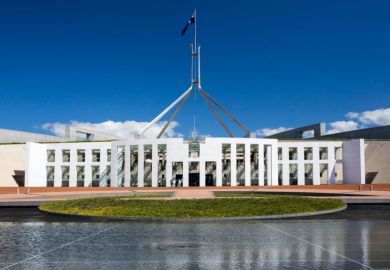Legislation aimed at reducing outstanding student debt in Australia has been deferred after parliament’s upper house ran out of time to vote on it.
Times Higher Education understands that Senate plans to debate the “student loan sustainability” bill will not proceed on 28 June because senators agreed to focus on national security legislation.
This means that the bill cannot be finalised before parliament sits again on 13 August.
Under the legislation, the threshold at which former students must start repaying their debts would be lowered from the current level of A$55,874 (£31,400) to A$45,000. The bill also changes the indexation formula applied to the threshold, so that it rises more slowly than it has in recent years.
The bill would also prevent students from accumulating debts of more than A$104,400, or A$150,000 in the expensive disciplines of medicine, dentistry and veterinary science.
The government had hoped to get the bill passed during the current parliamentary sitting, which ends today, because some of the provisions were due to take effect on 1 July.
Education minister Simon Birmingham said that he would bring the legislation back for consideration in the next sitting period. “The government is committed to ensuring that a Higher Education Loan Programme loan will still be one of the cheapest you will ever get, but also that Australia’s generous student loan system is sustainable into the future,” he said.
“The reality is Australia is faced with almost A$54 billion of taxpayer student loans that remain outstanding, and around a quarter of these loans are never expected to be repaid.”
The government was quietly confident of passing the legislation despite trenchant opposition from student groups, the Labor opposition and the Greens.
Complicating matters, minor party and independent senators have tabled four competing amendments. One senator wants the proposed repayment threshold raised to A$50,000. Another wants it lowered to A$25,000. A third seeks the elimination of a 25 per cent loan fee, which applies only to students at private colleges, while a fourth wants a 7.5 per cent loan fee imposed on all student loans.
On 26 June, the government paved the ground for debate on the bill by releasing the latest data on very high individual student debts. It said that more than 14,000 borrowers had racked up liabilities of at least A$100,000 each, collectively owing over A$1.7 billion.
Topping the list was a staggering A$536,000 owed by a borrower in New South Wales and A$459,000 by one in Victoria.
Meanwhile, the government has been quietly reducing the debt load with other rule changes. Under arrangements that apply from this year, students of private colleges and Open Universities Australia lose access to income-contingent loans if they fail to pass more than half of their units.
They can requalify for loans only by paying upfront fees and studying until their pass rates reach 50 per cent.
This is an extension of rules applied last year to a disastrously mismanaged diploma loan scheme, in which pass rates were about 20 per cent. But the Australian Council for Private Education and Training questioned whether it was necessary in higher education, where success rates have been relatively high.
Chief executive Rod Camm said that it was another example of policy settings that discriminated against private college students, like the 25 per cent loan fee. “It appears to continue the government’s anti-industry sentiment in the space,” he said.
Register to continue
Why register?
- Registration is free and only takes a moment
- Once registered, you can read 3 articles a month
- Sign up for our newsletter
Subscribe
Or subscribe for unlimited access to:
- Unlimited access to news, views, insights & reviews
- Digital editions
- Digital access to THE’s university and college rankings analysis
Already registered or a current subscriber?








